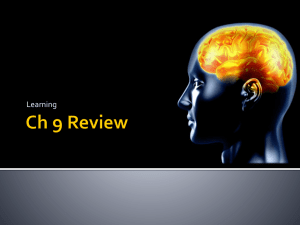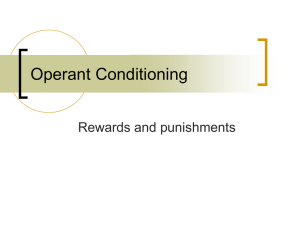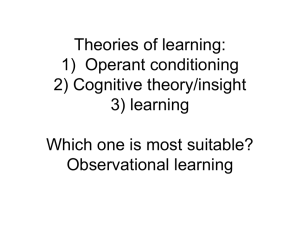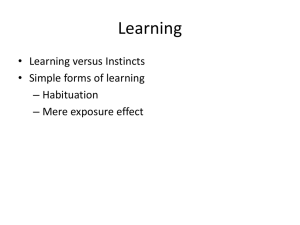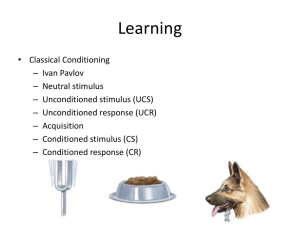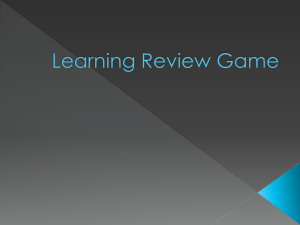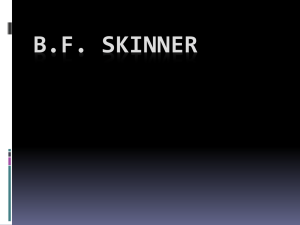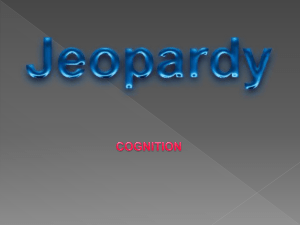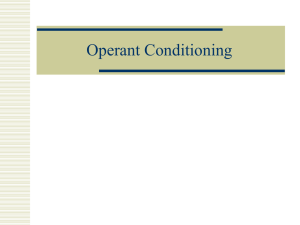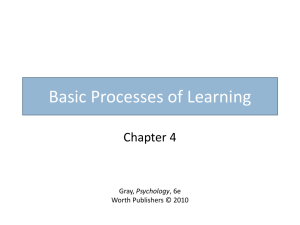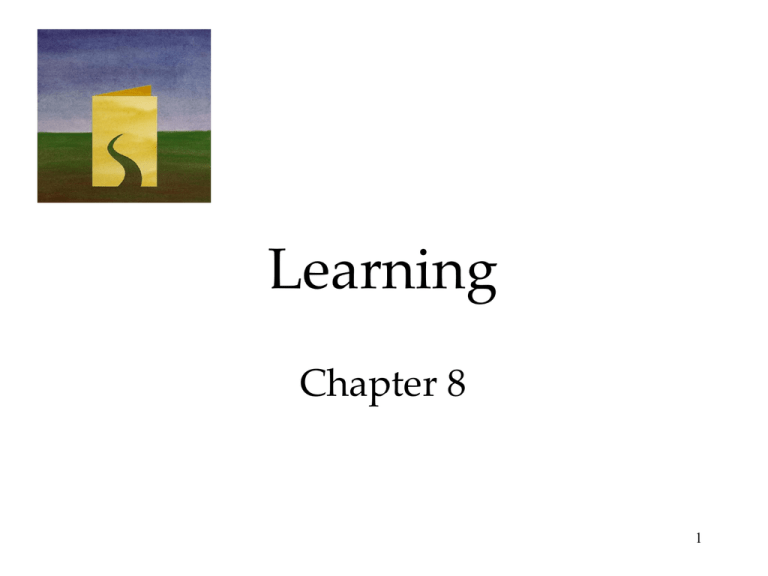
Learning
Chapter 8
1
Learning
How Do We Learn?
Classical Conditioning
Pavlov’s Experiments
Extending Pavlov’s
Understanding
Pavlov’s Legacy
2
Learning
Operant Conditioning
Skinner’s Experiments
Extending Skinner’s
Understanding
Skinner’s Legacy
Contrasting Classical & Operant
Conditioning
3
Learning
Learning by Observation
Bandura’s Experiments
Applications of Observational
Learning
4
Definition
Learning is a relatively permanent change in an
organism’s behavior due to experience.
Learning is more flexible in comparison to the
genetically-programmed behaviors of Chinooks,
for example.
5
How Do We Learn?
Associative Learning-We learn by association. Our
minds naturally connect events that occur in sequence.
2000 years ago, Aristotle suggested this law of
association. Then 200 years ago Locke and Hume
reiterated this law.
6
Stimulus-Stimulus Learning
Learning to associate one stimulus
with another.
7
Stimulus-Stimulus Learning
Learning to associate one stimulus
with another.
8
Response-Consequence Learning
Learning to associate a response
with a consequence.
9
Response-Consequence Learning
Learning to associate a response
with a consequence.
10
Behaviorism
• Behaviorism- the
view that psychology
should be an objective
science that studies
behavior without
reference to mental
processes. Most
researchers disagree
with mental processes.
11
Watson Quote
• Give me a dozen healthy infants, well-formed, and
my own specified world to bring them up in and
I’ll guarantee to take any one at random and train
him to become any type of specialist I might
select—doctor, lawyer, artist, merchant-chief and,
yes, even beggar-man and thief, regardless of his
talents, penchants, tendencies, abilities, vocations,
and race of his ancestors. (1930)
12
Classical Conditioning
Sovfoto
Ideas of classical conditioning originate from old
philosophical theories. However, it was the
Russian physiologist Ivan Pavlov who elucidated
classical conditioning. His work provided a basis
for later behaviorists like John Watson and B. F.
Skinner.
Ivan Pavlov (1849-1936)
13
Pavlov’s Experiments
Before conditioning, food (Unconditioned
Stimulus, US) produces salivation
(Unconditioned Response, UR). However, the
tone (neutral stimulus) does not. Thus, UCSFOOD; UCR- SALIVATION
14
Pavlov’s Experiments
During conditioning, the neutral stimulus (tone)
and the US (food) are paired, resulting in
salivation (UR). After conditioning, the neutral
stimulus (now Conditioned Stimulus, CS) elicits
salivation (now Conditioned Response, CR); Thus
CS; TONE; and CR; SALIVATION
15
Acquisition
Acquisition is the initial stage in classical
conditioning in which an association between a
neutral stimulus and an unconditioned
stimulus takes place.
1. In most cases, for conditioning to occur, the
neutral stimulus needs to come before the
unconditioned stimulus.
2. The time in between the two stimuli should
be about half a second.
16
Acquisition
The CS needs to come half a second before the
US for acquisition to occur.
17
Extinction
When the US (food) does not follow the CS
(tone), CR (salivation) begins to decrease and
eventually causes extinction.
18
Spontaneous Recovery
After a rest period, an extinguished CR (salivation)
spontaneously recovers, but if the CS (tone) persists
alone, the CR becomes extinct again.
19
Stimulus Generalization
Tendency to respond to
stimuli similar to the CS is
called generalization.
Pavlov conditioned the
dog’s salivation (CR) by
using miniature vibrators
(CS) on the thigh. When he
subsequently stimulated
other parts of the dog’s
body, salivation dropped.
20
Stimulus Discrimination
Discrimination is the learned ability to distinguish
between a conditioned stimulus and other stimuli
that do not signal an unconditioned stimulus.
21
Extending Pavlov’s Understanding
Pavlov and Watson considered consciousness,
or mind, unfit for the scientific study of
psychology. However, they underestimated
the importance of cognitive processes and
biological constraints.
22
Cognitive Processes
Early behaviorists believed that learned
behaviors of various animals could be reduced
to mindless mechanisms.
However, later behaviorists suggested that
animals learn the predictability of a stimulus,
meaning they learn expectancy or awareness of a
stimulus (Rescorla, 1988).
23
Biological Predispositions
Pavlov and Watson believed that laws of
learning were similar for all animals.
Therefore, a pigeon and a person do not differ
in their learning.
However, behaviorists later suggested that
learning is constrained by an animal’s biology.
24
Biological Predispositions
Courtesy of John Garcia
Garcia showed that the duration
between the CS and the US may be
long (hours), but yet result in
conditioning. A biologically adaptive
CS (taste) led to conditioning and not
to others (light or sound).
John Garcia
25
Biological Predisposition related
to Classical Conditioning
Even humans can develop classically to
conditioned nausea.
26
Pavlov’s Legacy
Pavlov’s greatest contribution
to psychology is isolating
elementary behaviors from
more complex ones through
objective scientific
procedures.
Ivan Pavlov
(1849-1936)
27
Applications of Classical
Conditioning
Brown Brothers
Watson used classical
conditioning procedures to
develop advertising
campaigns for a number of
organizations, including
Maxwell House, making the
“coffee break” an American
custom.
John B. Watson
28
Applications of Classical
Conditioning
1. Alcoholics may be conditioned (aversively)
by reversing their positive-associations with
alcohol.
2. Through classical conditioning, a drug (plus
its taste) that affects the immune response
may cause the taste of the drug to invoke the
immune response.
29
Respondent Behavior- Operant &
Classical Conditioning
1. Classical conditioning
forms associations
between stimuli (CS
and US). Operant
conditioning, on the
other hand, forms an
association between
behaviors and the
resulting events.
30
Operant Behavior- Operant &
Classical Conditioning
2. Classical conditioning involves respondent
behavior that occurs as an automatic
response to a certain stimulus. Operant
conditioning involves operant behavior, a
behavior that operates on the environment,
producing rewarding or punishing stimuli.
31
Skinner’s Experiments
Skinner’s experiments extend Thorndike’s
thinking, especially his law of effect. This law
states that rewarded behavior is likely to occur
again.
Yale University Library
32
Using Thorndike's law of effect as a starting
point, Skinner developed the Operant chamber,
or the Skinner box, to study operant
conditioning.
Walter Dawn/ Photo Researchers, Inc.
33
From The Essentials of Conditioning and Learning, 3rd
Edition by Michael P. Domjan, 2005. Used with permission
by Thomson Learning, Wadsworth Division
Operant Chamber
Operant Chamber
The operant chamber,
or Skinner box, comes
with a bar or key that
an animal manipulates
to obtain a reinforcer
like food or water. The
bar or key is connected
to devices that record
the animal’s response.
34
Shaping
Shaping is the operant conditioning procedure
in which reinforcers guide behavior towards the
desired target behavior through successive
approximations.
Fred Bavendam/ Peter Arnold, Inc.
Khamis Ramadhan/ Panapress/ Getty Images
A rat shaped to sniff mines. A manatee shaped to discriminate
objects of different shapes, colors and sizes.
35
Types of Reinforcers
Any event that strengthens the behavior it
follows. A heat lamp positively reinforces a
meerkat’s behavior in the cold.
Reuters/ Corbis
36
Primary & Secondary Reinforcers
1. Primary Reinforcer: An innately reinforcing
stimulus like food or drink.
2. Conditioned Reinforcer: A learned
reinforcer that gets its reinforcing power
through association with the primary
reinforcer.
37
POSITIVE REINFORCERS
NEGATIVE REINFORCERS
PRIMARY
SECONDARY
PRIMARY
SECONDARY
Food
Money
Electric shock
Rejection
Water
Grades
Intense heat
Failure
Sex
Status
Pain of any
sort
Criticism
Warmth
Praise
Suffocation
Avoidance
Types of Reinforcers
• Positive Reinforcers – A reinforcer that when
presented increases the frequency of an operant.
• Ex. A hungry rat presses a bar in its cage and
receives food. The food is a positive condition for
the hungry rat. The rat presses the bar again, and
again receives food. The rat's behavior of pressing
the bar is strengthened by the consequence of
receiving food.
Types of Reinforcement
• Negative Reinforcers – A reinforcer that when
removed increases the frequency of an operant.
• Ex. A rat is placed in a cage and immediately
receives a mild electrical shock on its feet. The
shock is a negative condition for the rat. The rat
presses a bar and the shock stops. The rat receives
another shock, presses the bar again, and again the
shock stops. The rat's behavior of pressing the bar
is strengthened by the consequence of stopping the
shock.
Positive or Negative Reinforcement?
1.
2.
3.
4.
5.
6.
7.
8.
Police pulling drivers over and giving prizes for
buckling up.
A child snaps her fingers until her teacher calls on her.
A hospital patient is allowed extra visiting time after
eating a complete meal.
Receiving a city utility discount for participating in a
recycling program.
Grounding a teenager until his/her homework is
finished.
A parent nagging a child to clean up her room.
A rat presses a lever to terminate a shock or a loud tone.
A professor gives extra credit to students with perfect
attendance.
1.
PR
2.
NR
3.
PR
4.
PR
5.
6.
7.
NR
NR
NR
8.
PR
Potential Negative Effects of Punishment
Recurrence
of undesirable
employee behavior
Undesirable
emotional reaction
Antecedent
Undesirable
employee
behavior
Punishment
by
manager
But
Short-term
leads
to
decrease in
frequency long-term
of
undesirable
employee
behavior
Aggressive,
disruptive
behavior
Apathetic,
noncreative
performance
Fear of
manager
Which tends
to reinforce
High turnover
and absenteeism
Schedules of Reinforcement
• Ratio Version –
having to do with
instances of the
behavior.
• Ex. – Reinforce or
reward the behavior
after a set number or x
many times that an
action or behavior is
demonstrated.
• Interval Version –
having to do with the
passage of time.
• Ex. – Reinforce the
student after a set
number or x period of
time that the behavior
is displayed.
4 Basic Schedules of Reinforcement
• Fixed-interval
schedule
• Variable-interval
schedule
• Fixed-ratio
schedule
• Variable-ratio
schedule
Fixed-Interval Schedule
• Fixed-interval schedule – A schedule in which a
fixed amount of time must elapse between the
previous and subsequent times that reinforcement
will occur.
• No response during the interval is reinforced.
• The first response following the interval is
reinforced.
• Produces an overall low rate of responding
• Ex. I get one pellet of food every 5 minutes when
I press the lever
Fixed Interval Reinforcement
Variable-Interval Schedule
• Variable-interval Schedule – A schedule
in which a variable amount of time must
elapse between the previous and subsequent
times that reinforcement is available.
• Produces an overall low consistent rate of
responding.
• Ex. – I get a pellet of food on average every
5 minutes when I press the bar.
Variable Interval Reinforcement
Fixed-Ratio Schedule
• Fixed-ratio Schedule – A schedule in which
reinforcement is provided after a fixed number of
correct responses.
• These schedules usually produce rapid rates of
responding with short post-reinforcement pauses
• The length of the pause is directly proportional to
the number of responses required
• Ex. – For every 5 bar presses, I get one pellet of
food
An Example of Fixed Ratio
Reinforcement
• Every fourth instance of a smile is reinforced
Fixed Ratio Reinforcement
Variable-Ratio Schedule
• Variable-ratio Schedule – A schedule in
which reinforcement is provided after a
variable number of correct responses.
• Produce an overall high consistent rate of
responding.
• Ex. – On average, I press the bar 5 times for
one pellet of food.
An Example of Variable Ratio
Reinforcement
• Random instances of the behavior are
reinforced
Variable Ratio Reinforcement
TYPE
MEANING
OUTCOME
Fixed
Ratio
Reinforcement depends
on a definite number of
responses
Activity slows after
reinforcement and
then picks up
Variable
Ratio
Number of responses
needed for
reinforcement varies
Greatest activity of
all schedules
Fixed
Interval
Reinforcement depends
on a fixed time
Activity increases
as deadline nears
Variable
Interval
Time between
reinforcement varies
Steady activity
results
Comparisons of Schedules of Reinforcement
SCHEDULE
FORM OF
REWARD
INFLUENCE ON
PERFORMANCE
EFFECTS ON
BEHAVIOR
Fixed interval
Reward on fixed
time basis
Leads to average
and irregular
performance
Fast extinction of
behavior
Fixed ratio
Reward tied to
specific number of
responses
Leads quickly to
very high and
stable
performance
Moderately fast
extinction of
behavior
Variable interval
Reward given after
varying periods of
time
Leads to
moderately high
and stable
performance
Slow extinction of
behavior
Variable ratio
Reward given for
some behaviors
Leads to very high
performance
Very slow
extinction of
behavior
1.
2.
3.
4.
5.
FI,
VI,
FR,
or
VR?
When I bake cookies, I can only put one set in at a time, so
after 10 minutes my first set of cookies is done. After another
ten minutes, my second set of cookies is done. I get to eat a
cookie after each set is done baking.
After every 10 math problems that I complete, I allow myself
a 5 minute break.
I look over my notes every night because I never know how
much time will go by before my next pop quiz.
When hunting season comes around, sometimes I’ll spend all
day sitting in the woods waiting to get a shot at a big buck.
It’s worth it though when I get a nice 10 point.
Today in Psychology class we were talking about Schedules
of Reinforcement and everyone was eagerly raising their
hands and participating. Miranda raised her hand a couple of
times and was eventually called on.
1.
FI
2.
FR
3. VI
4.
VI
5.
VR
FI, VI, FR, or VR?
6. Madison spanks her son if she has to ask him three times to
clean up his room.
7. Emily has a spelling test every Friday. She usually does well
and gets a star sticker.
8. Steve’s a big gambling man. He plays the slot machines all
day hoping for a big win.
9. Snakes get hungry at certain times of the day. They might
watch any number of prey go by before they decide to
strike.
10. Mr. Vora receives a salary paycheck every 2 weeks.
t
11. Christina works at a tanning salon. For every 2 bottles of
lotion she sells, she gets 1 dollar in commission.
12. Mike is trying to study for his upcoming Psychology quiz.
He reads five pages, then takes a break. He resumes reading
and takes another break after he has completed 5 more
pages.
6. FR
7. FI
8. VR
9. VI
10. FI
11. FR
12. FR
FI, VI, FR, or VR?
13. Megan is fundraising to try to raise money so she can go on
the annual band trip. She goes door to door in her
neighborhood trying to sell popcorn tins. She eventually sells
some.
14. Kylie is a business girl who works in the big city. Her boss is
busy, so he only checks her work periodically.
15. Mark is a lawyer who owns his own practice. His customers
makes payments at irregular times.
16. Jessica is a dental assistant and gets a raise every year at the
same time and never in between.
17. Andrew works at a GM factory and is in charge of attaching 3
parts. After he gets his parts attached, he gets some free time
before the next car moves down the line.
18. Brittany is a telemarketer trying to sell life insurance. After so
many calls, someone will eventually buy.
13. VR
14. VI
15. VI
16. FI
17. FR
18. VR
Applications of Operant
Conditioning
• Programmed Learning
– A method of
learning in which
complex tasks are
broken down into
simple steps, each of
which is reinforced.
Errors are not
reinforced.
• Ex. – Hooked on
Phonics
Applications of Operant
Conditioning
• Socialization – Guidance of
people into socially desirable
behavior by means of verbal
messages, the systematic use
of rewards and punishments,
and other methods of
teaching.
• Ex. – Children play with other
children who are generous
and non-aggressive and avoid
those who are not.
Applications of Operant Conditioning
• Behavior Modification
Praise this
Ignore this
Applications of Operant
Conditioning
• Token Economy – An
environmental setting
that fosters desired
behavior by
reinforcing it with
tokens (secondary
reinforcers) that can
be exchanged for other
reinforcers.
• Ex. – Book It!
Other Types of Learning
• Insight Learning – In Gestalt psychology,
a sudden perception of relationships among
elements of the “perceptual field”,
permitting the solution of a problem.
• Latent Learning – Learning that is hidden
or concealed.
• Observational Learning – Acquiring
operants by observing other engage in them.
Insight Learning
• Wolfgang Kohler –
German Gestalt
psychologist
• Experiments with
Chimpanzees
• Sultan learned to use a
stick to rake in bananas
placed outside his cage.
• When the bananas were
placed outside of Sultan’s
reach, he fitted two poles
together to make a single
pole long enough to reach
the food
Insight
Learning
“Aha” Learning
•
• Cognitive Map – A mental
representation or “picture” of
the elements in a learning
situation, such as a maze.
– Ex. – if someone pukes in the
hall that you usually take to
your next class you will still be
able to find your way because
of your mental representation
of this school.
Insight Learning
Latent Learning
• E.C. Tolman – experiment with rats.
• Rats learn about their environments
in the absence of reinforcement.
• Some rats went through maze for
food goals, while others were given
no reinforcement for several days.
• After 10 days, rewards were put in
with the rats that had previously
been given no rewards for 2 or 3
trials.
• Those rats reached the food box as
quickly as the rats that had been
getting reinforcement for over a
week.
• Rats learn about mazes in which
they roam even if they are
unrewarded for doing so.
•
•
•
•
•
Observational Learning
Albert Bandura
Bobo doll experiment
Assistant placed in room with doll
Beat doll with hammer and hit doll
Kindergarten children watched this
display of aggression in a separate
room.
• When placed in the room, they too
were extremely aggressive with the
doll
• Happened without ever being rewarded
for the behavior.
• http://www.npr.org/templat
es/story/story.php?storyId=
1187559
•Modeling
Monkey see, monkey do!
•Disinhibition
Get away with or are rewarded for violence
They always “get the girl/guy/money/car - etc.
•Increased arousal
Works the audience up
Watch the fans at a sporting event
Watch your friends watch the WWF
•Habituation
We become used to - desensitization
Immediate & Delayed Reinforcers
1. Immediate Reinforcer: A reinforcer that
occurs instantly after a behavior. A rat gets
a food pellet for a bar press.
2. Delayed Reinforcer: A reinforcer that is
delayed in time for a certain behavior. A
paycheck that comes at the end of a week.
We may be inclined to engage in small immediate
reinforcers (watching TV) rather than large delayed
reinforcers (getting an A in a course) which require
consistent study.
76
Reinforcement Schedules
1. Continuous Reinforcement: Reinforces the
desired response each time it occurs.
2. Partial Reinforcement: Reinforces a
response only part of the time. Though this
results in slower acquisition in the
beginning, it shows greater resistance to
extinction later on.
77
Ratio Schedules
1. Fixed-ratio schedule: Reinforces a response
only after a specified number of responses.
e.g., piecework pay.
2. Variable-ratio schedule: Reinforces a
response after an unpredictable number of
responses. This is hard to extinguish because
of the unpredictability. (e.g., behaviors like
gambling, fishing.)
78
Interval Schedules
1. Fixed-interval schedule: Reinforces a
response only after a specified time has
elapsed. (e.g., preparing for an exam
only when the exam draws close.)
2. Variable-interval schedule: Reinforces a
response at unpredictable time
intervals, which produces slow, steady
responses. (e.g., pop quiz.)
79
Schedules of Reinforcement
80
Punishment
An aversive event that decreases the behavior it
follows.
81
Punishment
Although there may be some justification for
occasional punishment (Larzelaere & Baumrind,
2002), it usually leads to negative effects.
1.
2.
3.
4.
Results in unwanted fears.
Conveys no information to the organism.
Justifies pain to others.
Causes unwanted behaviors to reappear in its
absence.
5. Causes aggression towards the agent.
6. Causes one unwanted behavior to appear in
place of another.
82
Extending Skinner’s Understanding
Skinner believed in inner thought processes and
biological underpinnings, but many
psychologists criticize him for discounting
them.
83
Cognition & Operant Conditioning
Evidence of cognitive processes during operant
learning comes from rats during a maze
exploration in which they navigate the maze
without an obvious reward. Rats seem to
develop cognitive maps, or mental
representations, of the layout of the maze
(environment).
84
Latent Learning
Such cognitive maps are based on latent
learning, which becomes apparent when an
incentive is given (Tolman & Honzik, 1930).
85
Motivation
Intrinsic Motivation:
The desire to perform a
behavior for its own
sake.
Extrinsic Motivation:
The desire to perform a
behavior due to
promised rewards or
threats of punishments.
86
Biological Predisposition
Photo: Bob Bailey
Biological constraints
predispose organisms to
learn associations that
are naturally adaptive.
Breland and Breland
(1961) showed that
animals drift towards
their biologically
predisposed instinctive
behaviors.
Marian Breland Bailey
87
Skinner’s Legacy
Skinner argued that behaviors were shaped by
external influences instead of inner thoughts and
feelings. Critics argued that Skinner
dehumanized people by neglecting their free will.
Falk/ Photo Researchers, Inc
.
88
Applications of Operant
Conditioning
Skinner introduced the concept of teaching
machines that shape learning in small steps and
provide reinforcements for correct rewards.
LWA-JDL/ Corbis
In School
89
Applications of Operant
Conditioning
Reinforcement principles can enhance athletic
performance.
In Sports
90
Applications of Operant
Conditioning
Reinforcers affect productivity. Many companies
now allow employees to share profits and
participate in company ownership.
At work
91
Applications of Operant
Conditioning
In children, reinforcing good behavior increases
the occurrence of these behaviors. Ignoring
unwanted behavior decreases their occurrence.
92
Operant vs. Classical Conditioning
93
Learning by Observation
© Herb Terrace
Higher animals,
especially humans,
learn through observing
and imitating others.
©Herb Terrace
The monkey on the
right imitates the
monkey on the left in
touching the pictures in
a certain order to obtain
a reward.
94
Reprinted with permission from the American
Association for the Advancement of Science,
Subiaul et al., Science 305: 407-410 (2004)
© 2004 AAAS.
Mirror Neurons
Neuroscientists discovered mirror neurons in
the brains of animals and humans that are active
during observational learning.
95
Learning by observation
begins early in life. This
14-month-old child
imitates the adult on TV
in pulling a toy apart.
Meltzoff, A.N. (1998). Imitation of televised models by infants.
Child Development, 59 1221-1229. Photos Courtesy of A.N. Meltzoff and M. Hanuk.
Imitation Onset
96
Bandura's Bobo doll
study (1961) indicated
that individuals
(children) learn
through imitating
others who receive
rewards and
punishments.
Courtesy of Albert Bandura, Stanford University
Bandura's Experiments
97
Applications of Observational
Learning- Modeling
Unfortunately,
Bandura’s studies
show that antisocial
models (family,
neighborhood or TV)
may have antisocial
effects. Must model
acceptable social
behavior
98
Positive Observational Learning
Bob Daemmrich/ The Image Works
Fortunately, prosocial (positive, helpful) models
may have prosocial effects.
99
Gentile et al., (2004)
shows that children in
elementary school
who are exposed to
violent television,
videos, and video
games express
increased aggression.
Ron Chapple/ Taxi/ Getty Images
Television and Observational
Learning
100
Modeling Violence
Children modeling after pro wrestlers
Glassman/ The Image Works
Bob Daemmrich/ The Image Works
Research shows that viewing media violence
leads to an increased expression of aggression.
101

